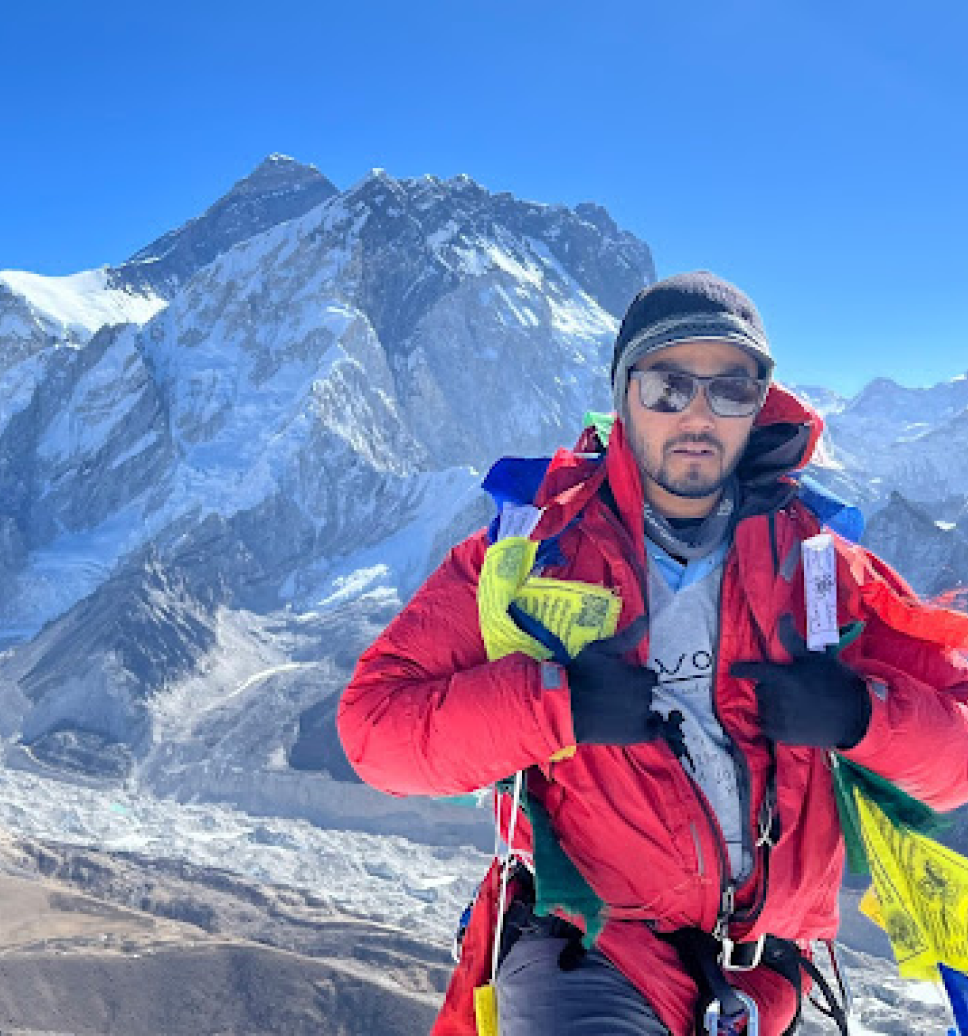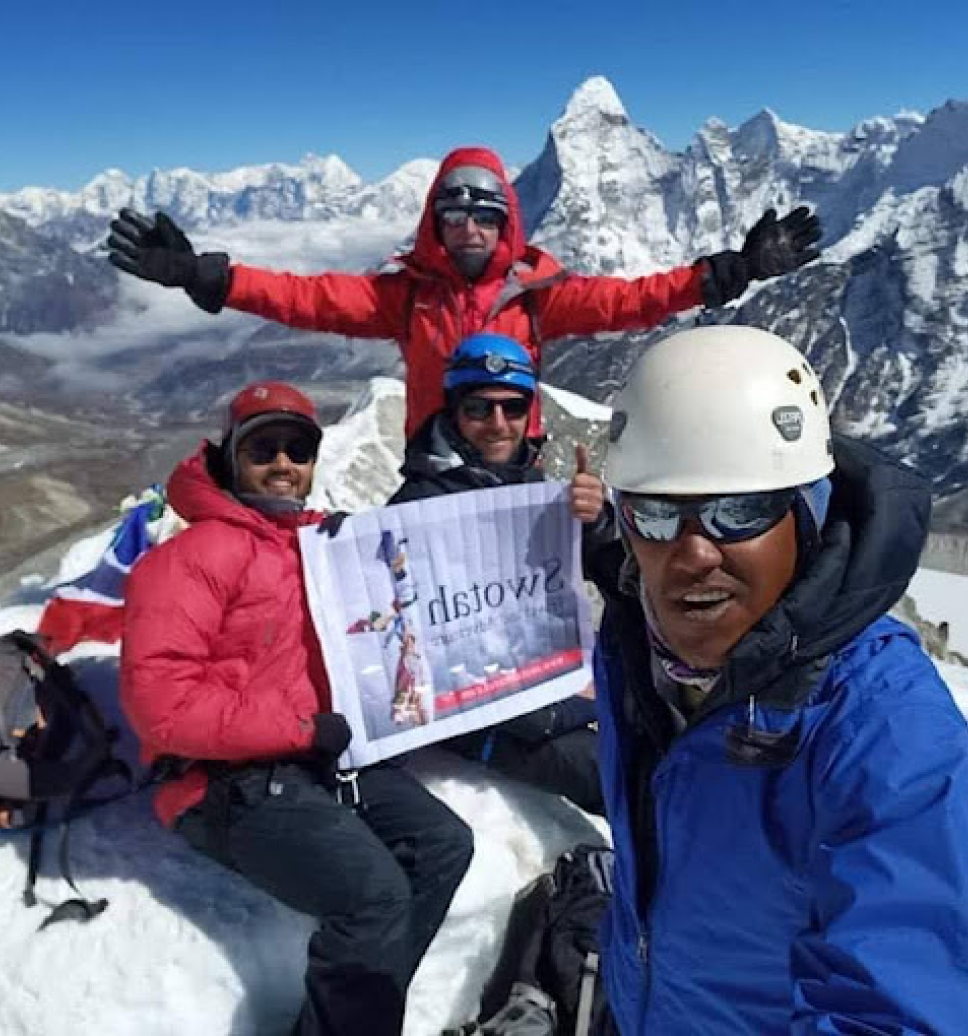GUARANTEED DEPARTURES
Check upcoming trip dates, availability & prices. If you can't see dates that suite you, contact us we will do our best to assist you.
| GUARANTEED DEPARTURES | PRICE | AVAILABILITY | |
| Mar 5, 2026 - Mar 21, 2026 | $2495 | High | |
| Mar 14, 2026 - Mar 31, 2026 | $2515 | High | |
| Apr 8, 2026 - Apr 25, 2026 | $2515 | High | |
| May 2, 2026 - May 19, 2026 | $2515 | High | |
| Sep 3, 2026 - Sep 19, 2026 | $2495 | High |
Trek Highlights
- Island Peak is also known as Imja Tse.
- The peak was named Island Peak in 1951 by Eric Shipton.
- Island Peak was first climbed by a British Expedition in 1953 as a part of the training exercise.
- At the elevation of 20,305 feet with Lat/Lon: 27.92°N, 86.93°E.
- Offers splendid views of gigantic mountains such as Mount Nuptse (7,879m), Mount Lhotse (8,501m), and Lhotse Middle (8,410m). Lhotse Shar (8,383m), Mount Makalu (8,475m), Baruntse (7,129m), Ama Dablam (6,812m) and many other Himalayan peaks.
- Exploration of Sherpa culture, tradition and religion.
- Visit the Tengboche monastery and other shrines and gompas on the way.
- The best times to visit Island Peak are April, May, October, and November.

Island Peak climbing is a wonderful adventure that takes you to some of the world's most exotic passes: Renjo La Pass (5,338m), Chola Pass (5,420m), and Kala Pattar (5,545m). It also provides a unique opportunity to explore the fascinating Sherpa culture. This trip is sure to give you confidence and experience in mountaineering for future ventures.
Photo Gallery
Dive into our gallery to get a glimpse of the awe-inspiring vistas waiting for you on our guided treks across stunning landscapes.
Brief Itinerary
Day
1
Arrival in Kathmandu (1,400m / 4,593 ft)
Day
2
Kathmandu Sightseeing
Day
3
Drive to Manthali, Flight to Lukla, and Trek to Phakding (2,656m / 8,714 ft)
Day
4
Trek to Namche Bazaar (3,450m / 11,319 ft)
Day
5
ACCLIMATIZATION
Day
6
TREK TO TENGBOCHE
Day
7
TREK TO DINGBOCHE
Day
8
TREK TO LOBUCHE
Day
9
TREK TO GORAKSHEP/EVEREST BASE CAMP
Day
10
TREK TO KALAPATTHAR/DINGBOCHE
Day
11
TREK TO CHUKUNG
Day
12
REST DAY
Day
13
ISLAND PEAK
Day
14
TREK TO TENGBOCHE
Day
15
TREK TO NAMCHE BAZAR
Day
16
TREK TO PHAKDING/LUKLA
Day
17
FLYING BACK TO KATHMANDU
Day
18
DEPARTURE
Comprehensive Trek Guide
The trek comes with a climbing experience and is beginner-friendly! What more can a trekker wish for? The Island peak climbing trek is 19 days long and ideal for those fond of physical activities and the Himalayas.
Crossing some of the most exotic passes in the world, passing through typical and rich culture, traditions, food, and villages, along with the panoramic view, makes this Island peak climbing trek one of a kind. First, trekkers will be spellbound by magical Kathmandu sightseeing, then move for the actual trek starting from Lukla, followed by Everest base camp and eventually to Island Peak, also widely known as Imja Tse.
On the trail of The Island peak climbing trek, one will get close to beautiful villages, local people with warm, hospitable nature and Renjo La Pass (5,338m / 17513.12 ft), Chola Pass (5,420m / 17782.15 ft), and Kala Patthar (5,545m / 18192.26 ft)The Island peak climbing trek is exciting and has a fair chance of altitude sickness, so it is good to have your health in check and consult your doctor beforehand.
The Island Peak is the most sought-after option for climbing. That has a stunning west face rising from Lhotse Glacier. There are not many technical aspects that go into climbing the Island Peak (6,189m/20,305ft), and it is also one of the best as an initial attempt for emerging climbers.Best for both climbing and trekking experiences at once, accompanied by breathtaking nature's presence throughout, is here for you, so gear up and get going for the Island peak climbing trek.
Location and Climbing Route of Island Peak (Imja Tse)
Island Peak (Imja Tse) is located in the Khumbu region of Nepal, nestled within the stunning Imja Valley. It is part of the Sagarmatha National Park, a UNESCO World Heritage Site, and is surrounded by some of the most iconic Himalayan giants, including Lhotse (8,516m), Ama Dablam (6,812m), and Makalu (8,485m). The peak lies just south of the massive Lhotse Shar and is an extension of its southeast ridge. Its strategic location makes it an integral part of the Everest Base Camp Trek, as the trail to its base camp branches off from the main trekking route.
Island Peak earned its name from a British expedition team in 1953, who observed that the mountain appeared like an island floating amidst a sea of ice when viewed from Dingboche. Locally, it is known as Imja Tse, a name given in 1983 by Nepal's government. Regardless of which name is used, the peak is widely recognized as one of the most accessible and popular trekking peaks in Nepal.
- Base Camp to High Camp (Optional): While some climbers begin the summit push directly from Base Camp, others opt for High Camp (5,500m / 18,044 ft) to shorten the summit day. High Camp is located closer to the glacier, providing a better starting point for the challenging ascent, though the limited water supply and colder conditions can make it more demanding.
- High Camp to Crampon Point: The climb begins early in the morning (around 1:00 AM) with a steep rocky ascent. After 2-3 hours, climbers reach crampon point, where the glacier begins. Here, climbers gear up with crampons, harnesses, and ice axes, and the team ropes up for safety.
- Glacier Traverse: The route crosses an undulating glacier with crevasses and snow bridges. Fixed ropes and ladders are used to navigate this section. This part of the climb offers stunning views of the surrounding Himalayan giants and the glacial terrain.
- The Headwall: The most challenging section of the climb is the headwall, a 100-meter vertical ascent on a narrow ridge. Climbers use fixed ropes and a jumar to make their way up. This section requires focus, patience, and proper technique, as the steep gradient and thin air make it physically demanding.
- Summit Ridge: After conquering the headwall, climbers reach the summit ridge, a narrow but relatively straightforward path leading to the summit. The ridge offers breathtaking 360-degree views of the Himalayas, including Lhotse, Ama Dablam, Makalu, and the surrounding peaks.
- The Summit (6,189m / 20,305 ft) :The summit of Island Peak is the ultimate reward, offering climbers a sense of accomplishment and stunning views. While Mount Everest cannot be seen from the summit due to Lhotse blocking the view, the surrounding peaks provide a spectacular panorama.
- Descent: After reaching the summit, climbers descend via the same route, carefully abseiling down the headwall and retracing their steps across the glacier to Base Camp or High Camp. The descent requires equal focus and effort, as most accidents happen during this phase. From Base Camp, climbers typically trek back to Chhukung or Dingboche for rest.
Climbing Difficulty of Island Peak
Island Peak is often regarded as a "trekking peak," but its climb is far from simple. It involves a combination of high altitude, technical sections, and physically demanding terrain, making it a challenging yet rewarding experience for climbers of all levels.
At 6,189 meters (20,305 feet), Island Peak presents significant altitude challenges. The thin air at such elevations makes breathing difficult and increases the risk of Acute Mountain Sickness (AMS). Proper acclimatization and a gradual ascent are essential to minimize these risks and enhance performance on summit day.
The technical aspects of the ascent, particularly the glacier traverse, the headwall, and the summit ridge, make it far more demanding than a typical trek. Climbers must use crampons, ice axes, and fixed ropes to cross crevasses, ascend the steep 100-meter headwall, and carefully traverse the narrow summit ridge, which requires focus and balance due to exposure on both sides.
The physical demands of Island Peak are considerable, as the climb includes long, steep ascents and sustained effort in challenging conditions. Summit day alone can take 10–12 hours, testing climbers’ endurance and determination. Adding to the difficulty are unpredictable weather conditions, which include sub-zero temperatures, high winds, and intense sunlight, making proper gear and preparation crucial. While Island Peak is often seen as an introduction to Himalayan mountaineering, it is not without its challenges.
Novice climbers can attempt the climb with the help of experienced Sherpas and proper training in the use of mountaineering equipment and techniques. Mental resilience is also key, especially when tackling the headwall and summit ridge, which demand patience and focus.
Tipping Recommendation
We recommend allocating 10-15% of your total tour cost to tipping guides, drivers, and other hardworking staff who ensure your experience is unforgettable. While tipping is not mandatory, it is a meaningful way to support the seasonal workers who dedicate themselves to making your trip extraordinary.By booking with us and participating in the tipping culture, you are directly contributing to Nepal's local economy and helping sustain the tourism workforce. This support is crucial in retaining talent within the country and addressing challenges like brain drain.Your generosity makes a lasting impact-thank you!
Detailed Itinerary
Meals: Dinner
Accommodation: Hotel
Meals: Breakfast
Accommodation: Hotel
Meals: Breakfast,Lunch,Dinner
Accommodation: Teahouse
Meals: Breakfast,Lunch,Dinner
Accommodation: Teahouse
Meals: Breakfast,Lunch,Dinner
Accommodation: Teahouse
Meals: Breakfast,Lunch,Dinner
Accommodation: Teahouse
Meals: Breakfast,Lunch,Dinner
Accommodation: Teahouse
Meals: Breakfast,Lunch,Dinner
Accommodation: Teahouse
Meals: Breakfast,Lunch,Dinner
Accommodation: Teahouse
Meals: Breakfast,Lunch,Dinner
Accommodation: Teahouse
Meals: Breakfast,Lunch,Dinner
Accommodation: Teahouse
Meals: Breakfast,Lunch,Dinner
Accommodation: Teahouse
Meals: Breakfast,Lunch,Dinner
Accommodation: Teahouse
Meals: Breakfast,Lunch,Dinner
Accommodation: Teahouse
Meals: Breakfast,Lunch,Dinner
Accommodation: Teahouse
Meals: Breakfast,Lunch,Dinner
Accommodation: Hotel
Meals: Breakfast
Accommodation: Hotel
Meals: Breakfast
Accommodation: N/A
What's Included
- Airport transfers;
- Standard/Deluxe rooms in Kathmandu on a B/B basis;
- Full-day sightseeing in Kathmandu (Swayambhunath, Pashupatinath, Boudhnath and Durbar Square)
- Local English-speaking guide for sightseeing in Kathmandu;
- Necessary staff including experienced guides and porters during the trekking and climbing;
- Flight tickets for the Ramechaap/Kathmandu-Lukla-Ramechaap/Kathmandu sector to all climbing members and staff;
- All trekking and camping equipment like camp furniture, kitchenware, dining tents, guest tents, etc ;
- 3 meals a day (breakfast, lunch, and dinner with tea or coffee) along with available accommodation at hotel/lodge/guesthouses or tents for members and staff during the trek and climbing on a twin-sharing basis;
- Per person 15 kg baggage allowance during trekking-up carrying by porter (2:1);
- Trekking Permit (National Park entry fee) and local permit;
- Climbing permit for Island Peak;
- Required experienced, trained and government-licensed climbing guide(s) during the climbing period as per the size of the group;
- All wages, equipment, medical and accidental insurance for all involved staff;
- First aid medical kits for the group and the staff;
- Appropriate food for high altitude and all climbing crew at base camp and above as required;
- Required fixed and dynamic rope during the climbing period;
- All necessary paper works, office Service charges, and government taxes levied in Nepal;
- Complete pre-departure information, flight ticket reconfirmation, and visa extension procedure services (if necessary).
What's not Included
- Lunches and dinners in Kathmandu
- Travel and rescue insurance
- International flights and Nepalese visa fee
- All kinds of personal expenses
- Icefall fees and garbage deposit (shared with another member, if applicable)
- Walkie-talkies and filming permit
- Personal climbing guide (if requested)
- Optional trips and sightseeing (if extended)
- Excess baggage charges (if luggage exceeds 15 kg, approximately $1.5 per kg)
- Tips for guides and porters
Frequently Asked Question
1.What are the physical requirements for this trip
2.Will your company representative come to receive us upon arrival at arrival
3.What type of accommodation will you use at the Kathmandu and during the trek
4. How will my booking be processed
5.How can I pay the remaining payment after arriving at Kathmandu
6.What type of food can I get during the trek and is it healthy
7.Is safe drinking water available while climbing
8.What type of transportation do you use
9.What is the best season for the trekking
10.How far do I have to trek each day
11.Do your trekking guides have license and certificates in the tourism sector and have they received first aid training for the high altitude
12.What safety measures can your guides do during the emergency like high altitude sickness, accidents and dehydration
13.Are climbing guides well trained and have they already climbed this summit before
14.Do we need to book our own international flights to and from Nepal
15.During the trek, can we charge the camera and other equipments
16.Is there any communication system during the trek
17.Can I use credit card during this trip
18.How much additional money do I need to carry with me during the trek
19.Can I add extra days to my trekking trip
20.Do you prefer yak or porter on the trek or should we need to carry by ourselves
21.Can we store our clothes which are not necessary for the trek
22. What is the temperature rating of the sleeping bag that you lend of trekkers
23.How should I dress during the trek
24. Is it possible to change the lodge if it is not in order
25.Do you reserve rooms at the lodges before or during the trek
26. What immunization will I need
27.What about the security during trekking
28. Will there be a problem for a vegetarian
Got a question about this tour?
Or looking for customize trip, reach out to our travel experts





















